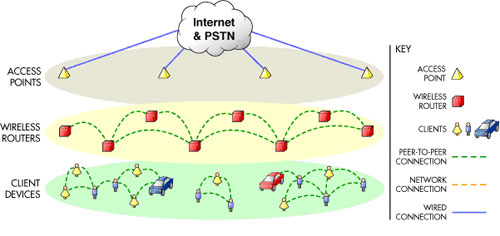Mesh-Networks
 Wireless Mesh Networks offer indispensible advantages for wireless network standards like Wireless Personal Area Networks (WPANs), Wireless Local Area Networks (WLANs) and Wireless Metropolitan Area Networks (WMANs or WiMAX). Unlike traditional MANETs which have no infrastructure, WMNs combines the advantages of both infrastructure and infrastructure less networks. The ad-hoc extension to the backbone or infrastructure devices consists of consumer devices called mesh clients. The client devices can be static or mobile and they interact with the backbone or infrastructure devices called mesh routers. The mesh routers consists of a multi-hop topology and can save cost by having only a few high bandwidth wired links to the gateways instead of every router having a wired connection. WMNs are self configuring and self healing networks. Since each device has a connection to every other device in its immediate neighbourhood, there are redundant links present in case of link failures. To increase capacity and reduce interference, mesh devices can communicate using multiple radios.
Wireless Mesh Networks offer indispensible advantages for wireless network standards like Wireless Personal Area Networks (WPANs), Wireless Local Area Networks (WLANs) and Wireless Metropolitan Area Networks (WMANs or WiMAX). Unlike traditional MANETs which have no infrastructure, WMNs combines the advantages of both infrastructure and infrastructure less networks. The ad-hoc extension to the backbone or infrastructure devices consists of consumer devices called mesh clients. The client devices can be static or mobile and they interact with the backbone or infrastructure devices called mesh routers. The mesh routers consists of a multi-hop topology and can save cost by having only a few high bandwidth wired links to the gateways instead of every router having a wired connection. WMNs are self configuring and self healing networks. Since each device has a connection to every other device in its immediate neighbourhood, there are redundant links present in case of link failures. To increase capacity and reduce interference, mesh devices can communicate using multiple radios.
Although WMNs can bring many advantages, there are issues present in each layer (PHY-NET) which need to be addressed so that WMNs can be utilized with their full potential. WNCG at Brunel University aims to target and resolve some of the major issues in WMNs e.g. distributed scheduling, admission control, congestion control, dynamic channel assignment strategies, efficient topology formation etc.